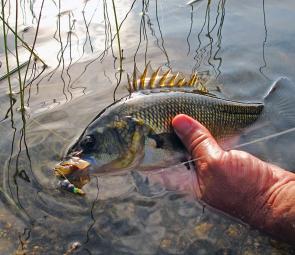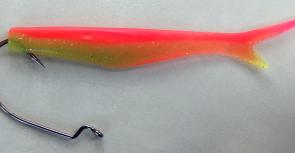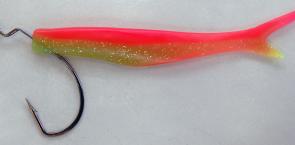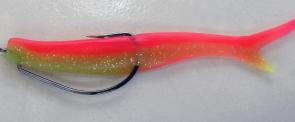In part two of his three-part series on the basics of soft plastics, I will detail a deadly rig for fishing these lures in snaggy or weedy waters.
While the basic method for rigging a plastic on a jighead described last month will serve you extremely well in the majority of scenarios, it’s worth knowing a few alternate strategies for more demanding or unusual situations.
One of the most valuable of these advanced presentation methods is the rigging of a soft plastic on a wide-gaped worm hook so that it resists snagging and fouling with weed. This is fairly easy to do, as shown in the accompanying images.
Begin by pushing the hook point through the front of the plastic for a short distance (usually about 3-10mm, depending upon the size of the plastic and the hook) before bringing the hook point out the lure’s ‘chin’. Pull the hook almost all the way through the plastic until the little kink or twist in the shank enters the nose of the lure and the hook eye sits snugly at the front of the plastic (if your hook is already tied to your leader, you can actually pull the hook eye and knot into the plastic).
Next, rotate the hook and measure it up across the lure body to ascertain the entry and exit points before pushing the point up into the belly of the lure and bringing it out the back. You need to be a bit careful with this part to avoid bending or deforming the finished rig. Study the accompanying photos closely, practice on a few old, chewed-up tails, and you’ll soon get the idea.
Rigged in this way, a plastic is extremely resistant to snagging or picking up weed but, hopefully, the hook point will push clear of the plastic and stick into the fish’s mouth on the strike… That’s the theory, anyway!
One additional trick, especially when working in really thick structure or dense weed, is to push the hook point almost all the way through the lure, but leave it partially buried inside the back of the plastic. In slightly less snaggy country, you can bring the point out and lay it flush along the back of the plastic.
Rigged this way, the point will not easily catch on the branches or rocks, nor readily pick up weed. When a fish eats your offering, you should give it a second or two to really swallow or inhale the lure, then strike extra hard, with a somewhat exaggerated upward sweep of the rod, combined with a few fast cranks of the reel’s handle. Theoretically, the hook point will punch clear of the plastic and stick into the fish. However, any method that snag-proofs a lure also tends to fish-proof it to some extent and, in my experience, you will miss hooking up on quite a few strikes. But if you’re able to cast your lures into places where you otherwise couldn’t (or wouldn’t), it may well be worth sacrificing a few hook-ups in return for many extra opportunities.
This weedless rig can be left un-weighted for shallow work, or weighted with a suitable sinker run on the leader or in the loop knot. It is absolutely deadly on barra and saratoga up north, bass and bream in the snags down south, snapper in reefy country, flathead in dense weed beds, or Murray cod and yellowbelly in our timber-studded outback waters… In fact, anywhere you’d like to cast a plastic while minimising snags and weed. Give it a try!
Next month I’ll look at how to choose the right plastics on the day.
1
Lots of switched-on northern anglers nowadays target barra on ‘weedless rigged’ plastics. The plastic has partially torn away from the hook during a torrid struggle with this nice barra.
2
Targeting bass in the weeds is another prime scenario for choosing to go weedless or snag-proof. Note the beads and small sinkers rigged in the loop knot.
3
Begin by inserting the hook point dead centre into the nose of the plastic and bringing it out the lure’s ‘chin’.
4
Carefully pull the hook right through until the kinked section of the shank enters the plastic’s nose.
5
Turn the hook and lay it across the plastic to accurately establish entry and exit points.
6
Push the hook up through the plastic, emerging as close to the centreline of its back as possible.
Reads: 5766









